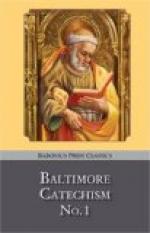239 Q. When did Christ institute the Holy Eucharist? A. Christ instituted the Holy Eucharist at the Last Supper, the night before He died.
“Last Supper,” on Holy Thursday night. (See Explanation of the Passion, Lesson 8, Question 78.)
240 Q. Who were present when Our Lord instituted the Holy Eucharist? A. When Our Lord instituted the Holy Eucharist the twelve Apostles were present.
241 Q. How did Our Lord institute the Holy Eucharist? A. Our Lord instituted the Holy Eucharist by taking bread, blessing, breaking, and giving to His Apostles, saying: “Take ye and eat. This is My body”; and then by taking the cup of wine, blessing and giving it, saying to them: “Drink ye all of this. This is My blood which shall be shed for the remission of sins. Do this for a commemoration of Me.”
“Eucharist” means thanks. Hence this Sacrament is called Eucharist, because Our Lord gave thanks before changing the bread and wine into His body and blood, and because the offering of it to God is the most solemn act of thanksgiving. “Do this”—that is, the same thing I am doing, namely, changing bread and wine into My body and blood. “Commemoration”—that is, to remind you of Me, that you may continue to do the same till the end of time.
242 Q. What happened when Our Lord said, “This is My body, this is My blood”? A. When Our Lord said, “This is My body,” the substance of the bread was changed into the substance of His body. When He said, “This is My blood,” the substance of the wine was changed into the substance of His blood.
“Substance” literally means that which stands underneath. Underneath what? Underneath the outward appearances or qualities—such as color, taste, figure, smell, etc.—that are perceptible to our senses. Therefore we never see the substance of anything. Of this seat, for instance, I see the color, size, and shape; I feel the hardness, etc.; but I do not see the substance, namely, the wood of which it is made. When the substance of anything is changed, the outward appearances change with it. But not so in the Holy Eucharist; for by a miracle the appearances of bread and wine remain the same after the substance has been changed as they were before. As the substance alone is changed in the Holy Eucharist, and as I cannot see the substance, I cannot see the change. I am absolutely certain, however, that the change takes place, because Our Lord said so; and I believe Him, because He could not deceive me. He is God, and God could not tell a lie, because He is infinite truth. This change is a great miracle, and that is the reason we cannot understand it, though we believe it. Once at a marriage in Cana of Galilee (John 2) Our Lord changed water into wine. The people were poor, and Our Lord, His Blessed Mother, and the Apostles were present at the wedding when the wine ran short; and our Blessed Lady, always so kind to everyone,




